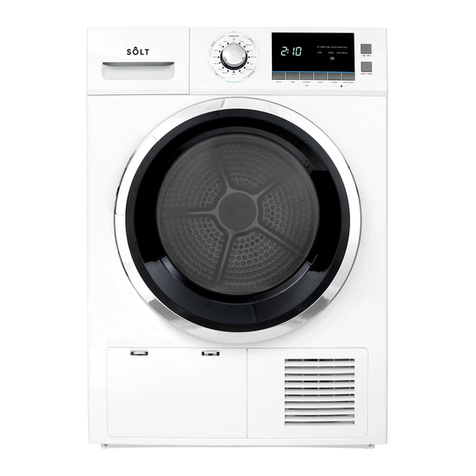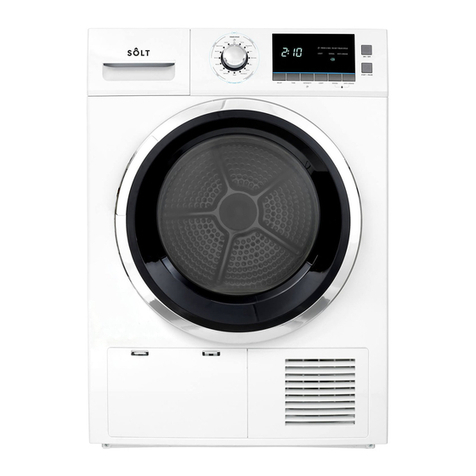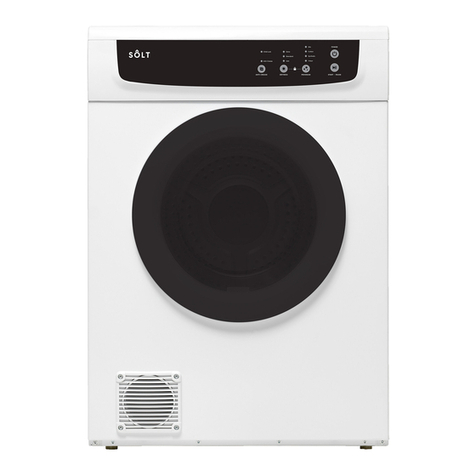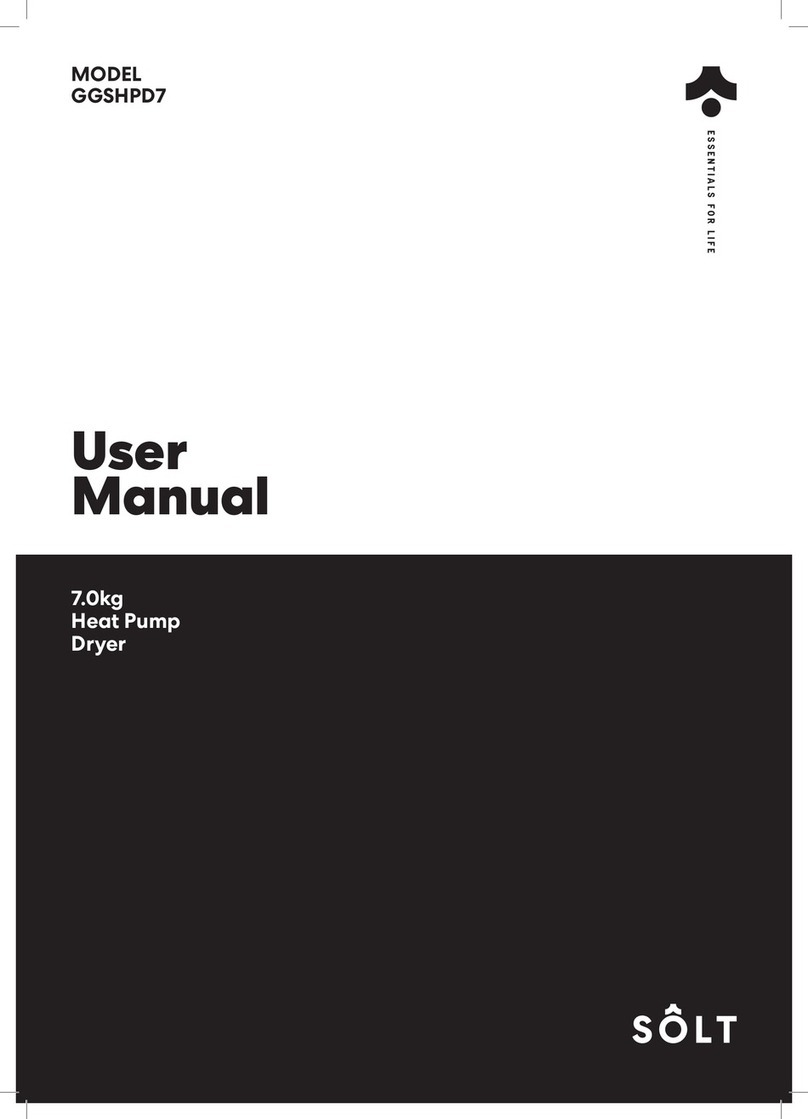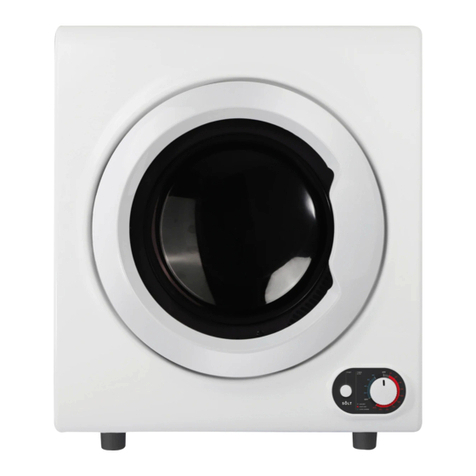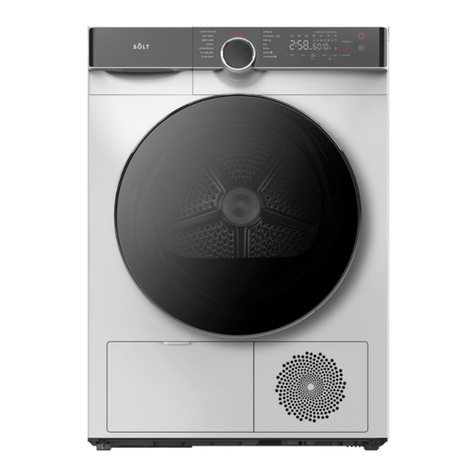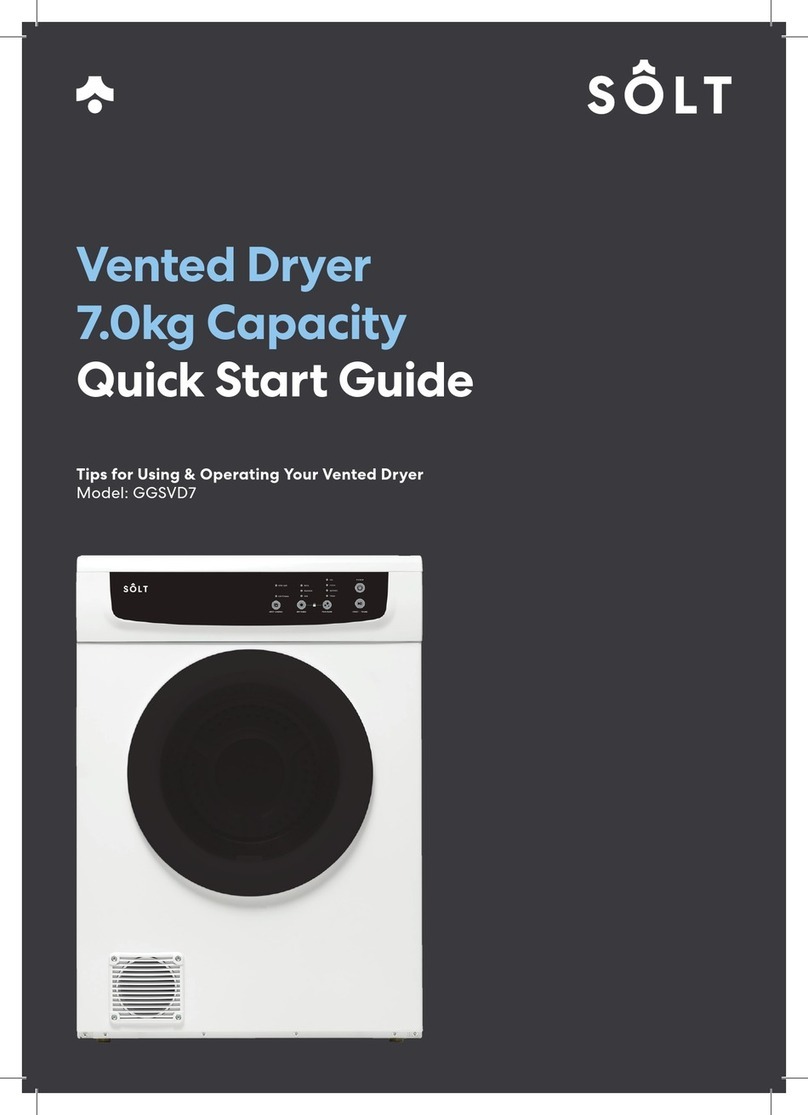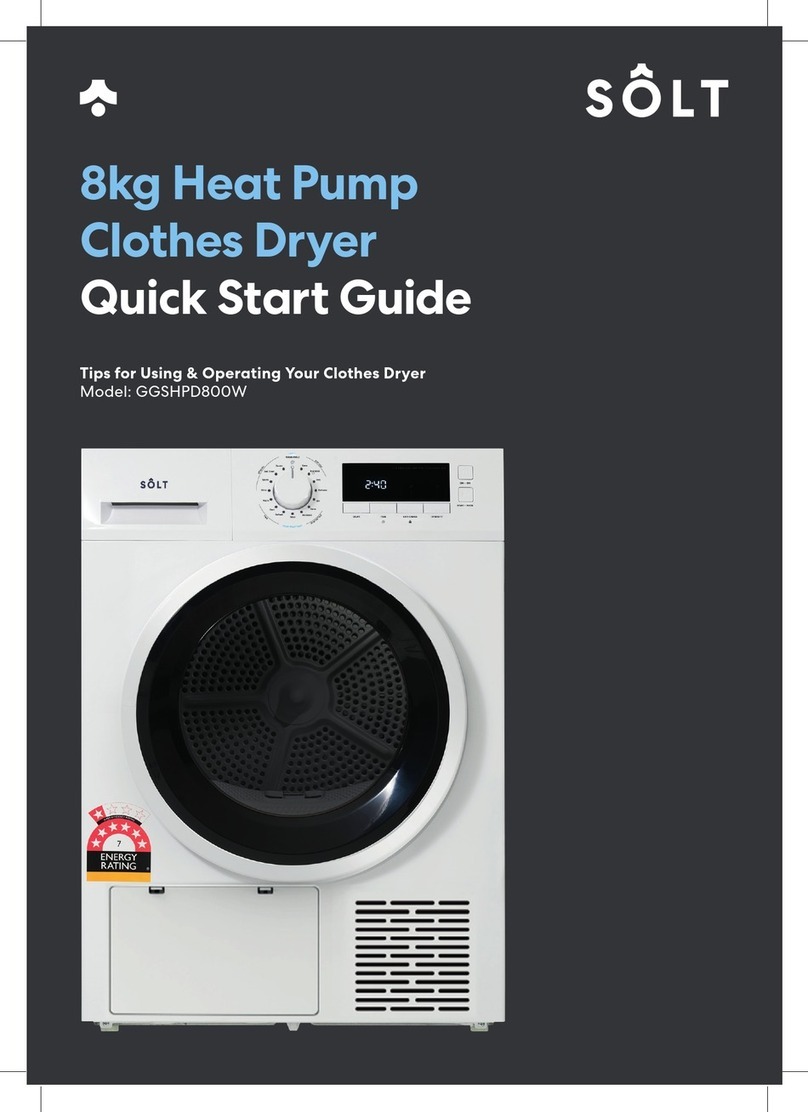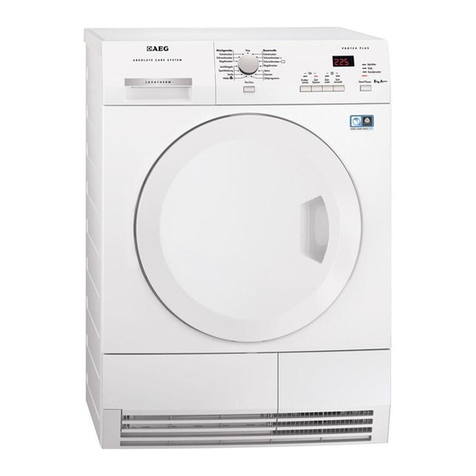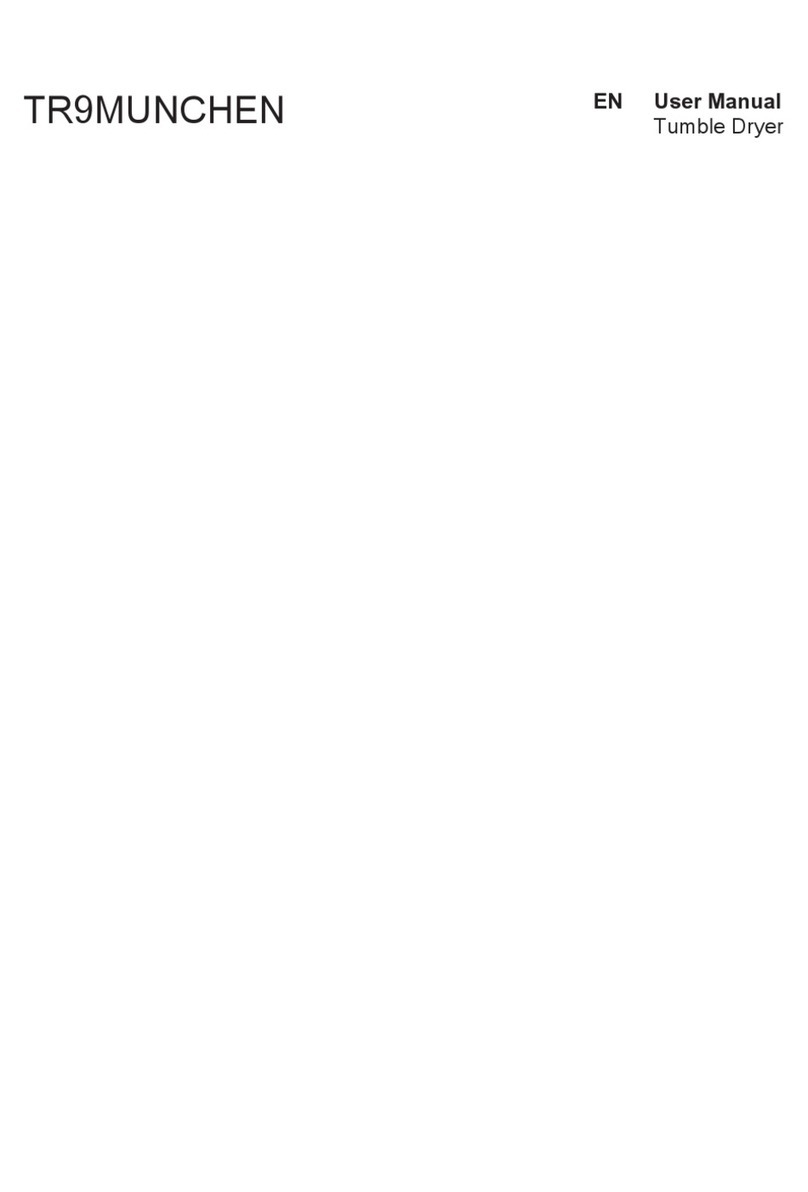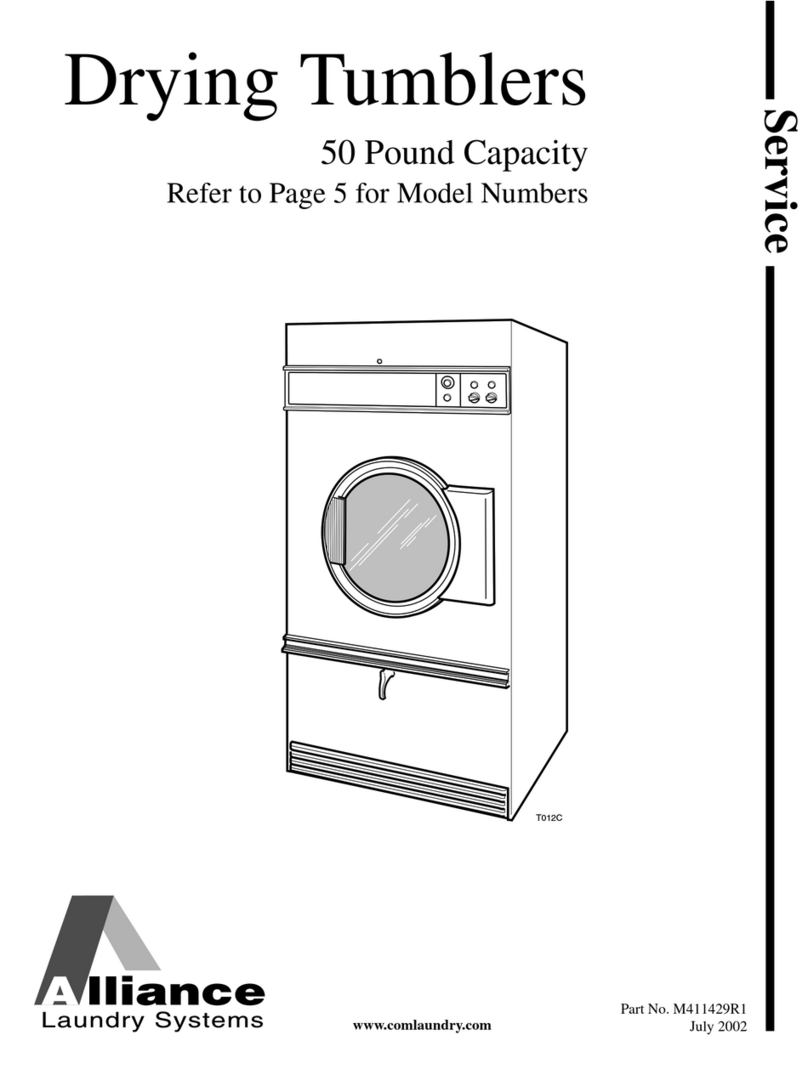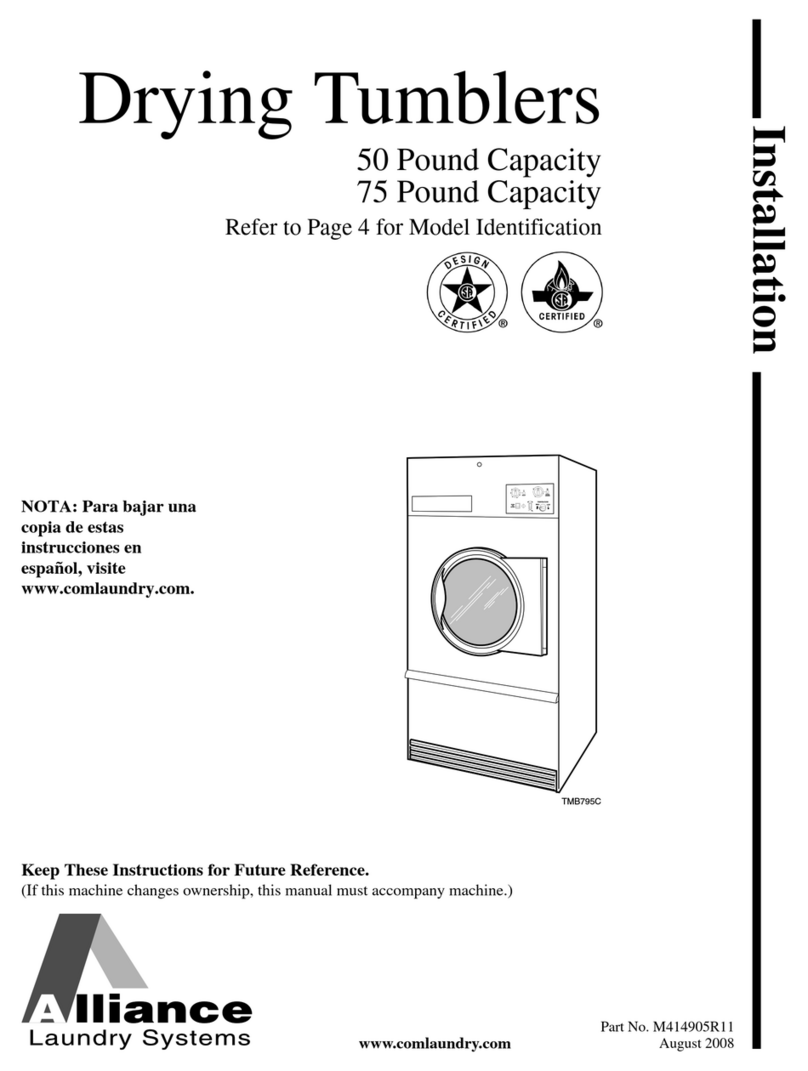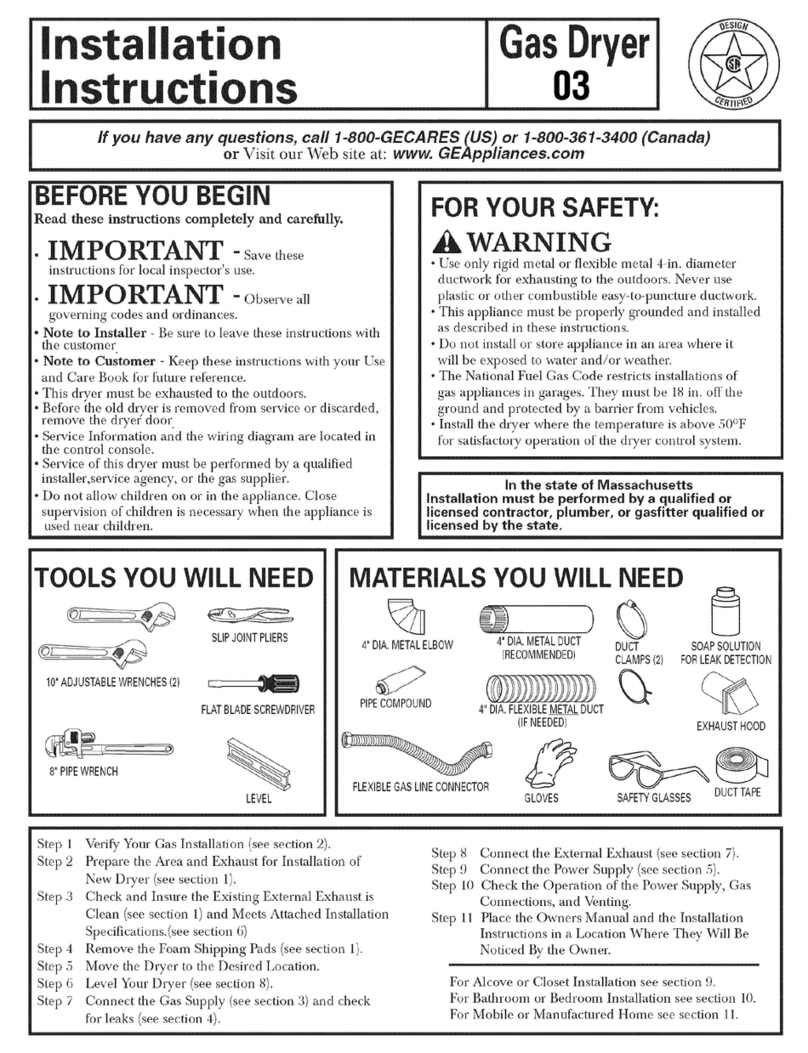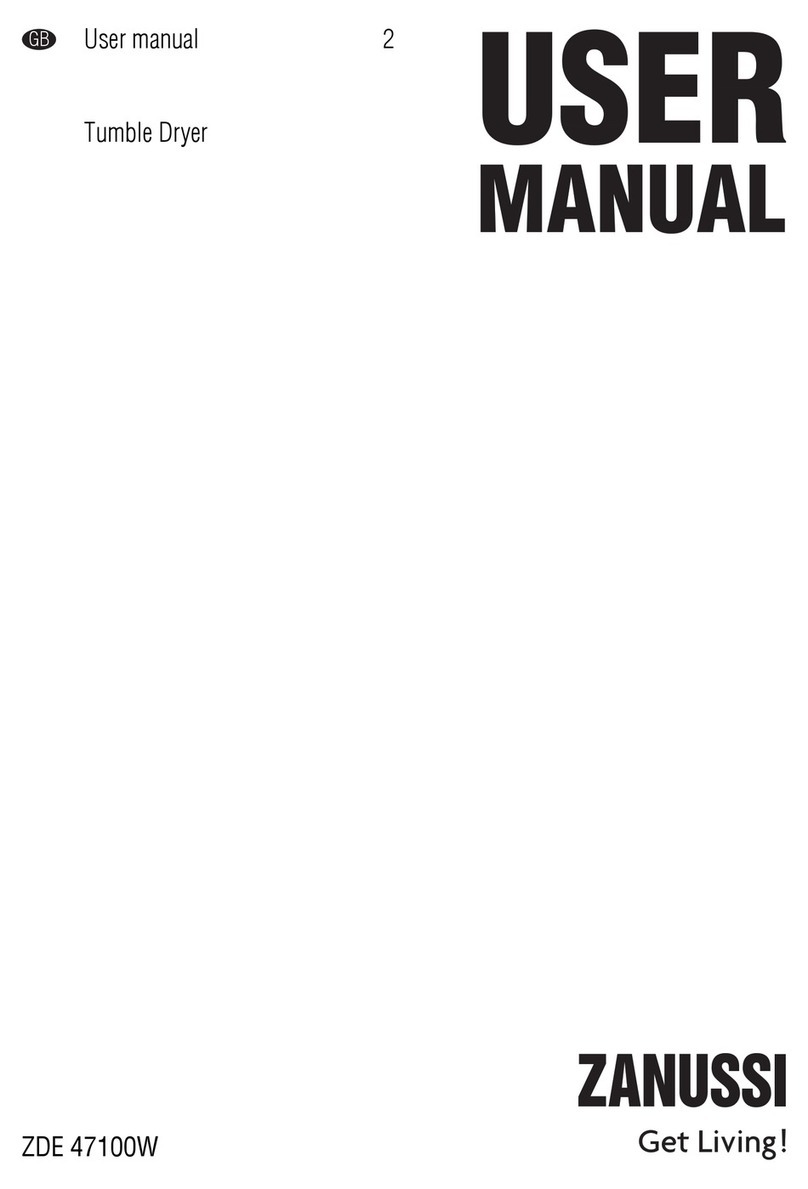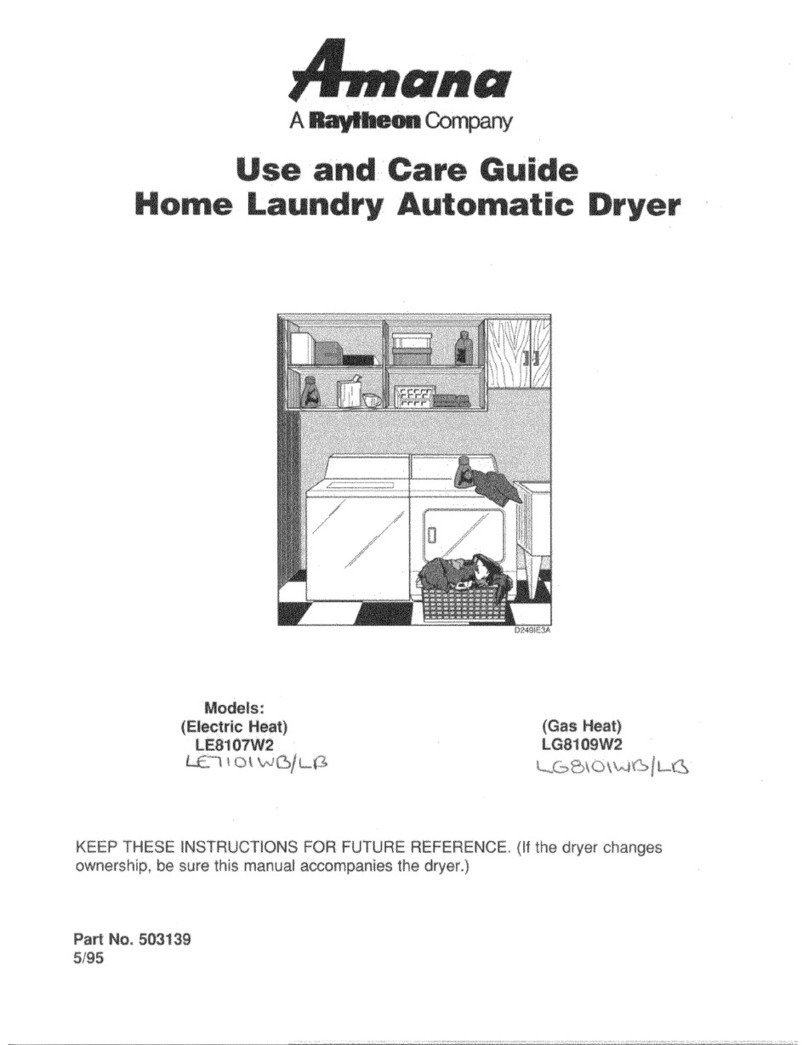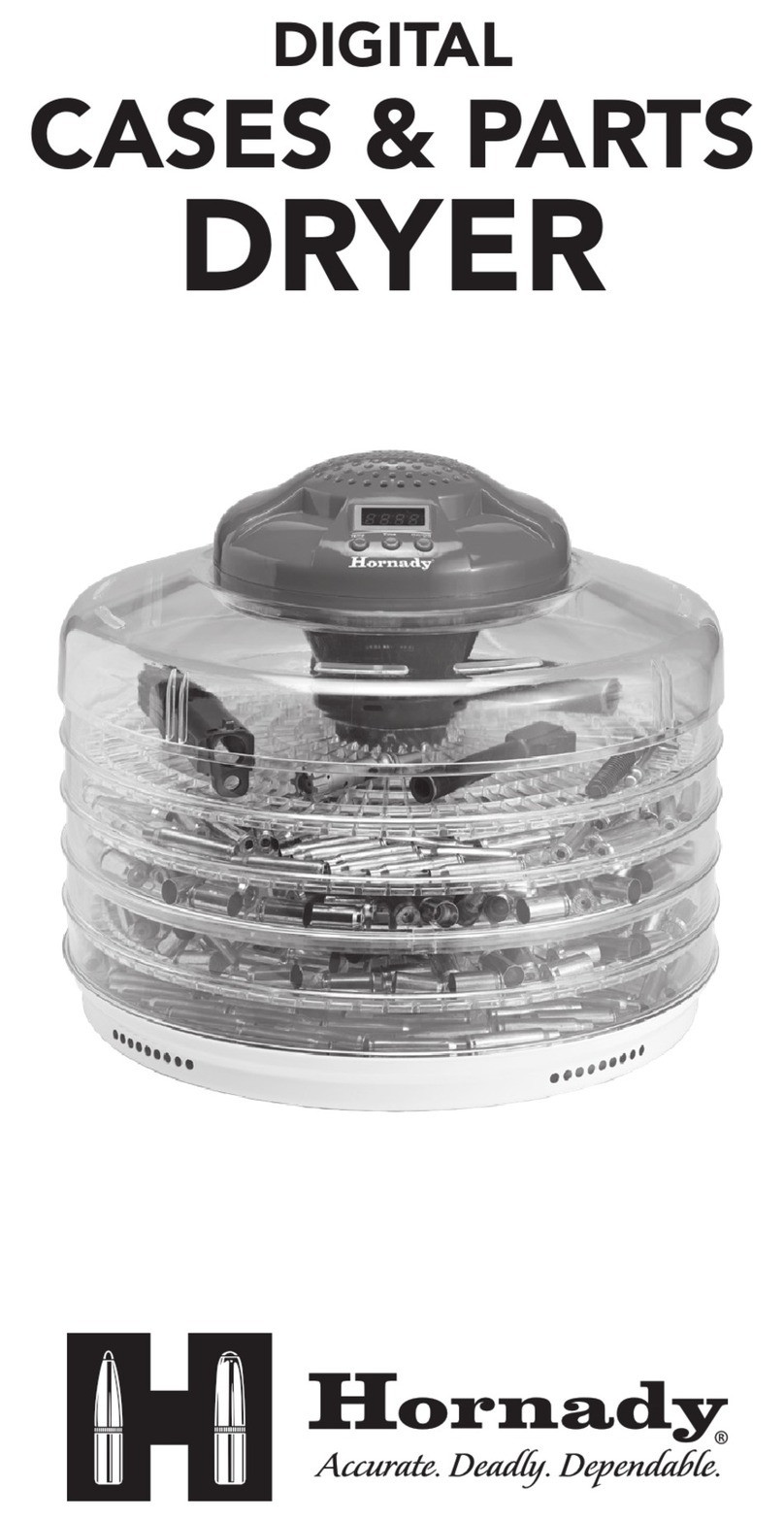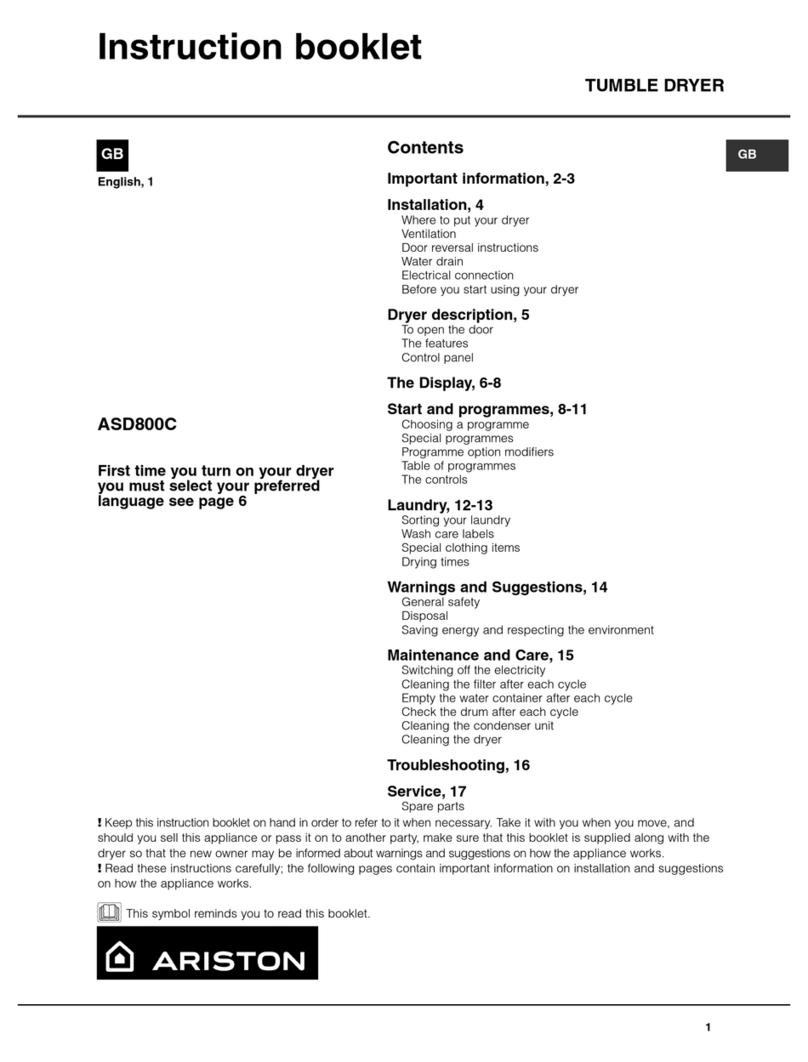Solt GGSVD7 User manual

E S S E N T I A L S FOR LIFE
User
Manual
MODEL
GGSVD7
7kg
Vented
Dryer
V4

2
Welcome Congratulations on purchasing
your new Vented Dryer!
The Sôlt brand is proudly distributed
within Australia by Residentia
Group Pty Ltd.
Please refer to the warranty card at the rear of this manual
for information regarding your product’s parts and labour
warranty, or visit us online at www.residentia.group
At Residentia Group, we are customer obsessed and our
Support Team are there to ensure you get the most out of
your appliance. Should you want to learn more about your
rangehood features, and importantly taking care of your
appliance when cleaning, our Support Team are here
to help.
You can use our online Support Centre at anytime by
visiting http://support.residentiagroup.com.au, or you can
contact us via calling us on 1300 11 HELP (4357).
It is important that you read through the following use and
care manual thoroughly to familiarise yourself with the
installation and operation requirements of your appliance
to ensure optimum performance.
Again, thank you for choosing an Sôlt appliance and we
look forward to being of service to you.
Kind Regards,
The Residentia Team
Residentia Group
—
Head Office.
165 Barkly Ave
Burnley
Victoria 3121
Australia
—
ACN.
600 546 656
—
Online.
residentia.group

Contents 2Welcome
4Safety Instructions
4Technical Specifications
8 Your Vented Dryer
9Control Panel
10 Before First Use
11 Accessory Kit Contents
12 Installation Instructions
14 Operating Your Vented Dryer
18 Cleaning and Maintenance
19 Troubleshooting
21 Purchase Details
22 Warranty Information

4
Safety Instructions
GENERAL SAFETY INSTRUCTIONS
DRYER SAFETY
WARNING! Failure to follow these safety instructions could damage the clothes dryer or your clothes. You may then
not be covered by warranty for this damage.
Only plug this appliance directly into an AC power supply which is properly earthed and had the correct voltage.
Refer to the appliance rating plate (located on the rear of your clothes dryer) for the voltage information.
Caution! If this appliance is supplied from an extension cord, power-board or other power adapter, the extension
cord/power-board must be positioned so that it is not subject to moisture or risk of moisture. For safety reasons, we
strongly advise against the use of double adaptors, power-boards, extension leads or other similar devices.
This appliance is not intended for use by persons (including children) with reduced physical, sensory or mental
capabilities, or lack of experience and knowledge, unless they have been given supervision or instruction concerning
use of the appliance by a person responsible for their safety. Children should be supervised to ensure that they do not
play with the appliance.
Important!
• If the electrical cord of this appliance is damaged, it must be replaced by the Manufacturer, Authorised Service
Agent or similarly qualified person in order to avoid a hazard. Damage to the appliance, including the power
cord, is not covered under the manufacturer’s warranty and a fee for service may be payable.
• These dryers are for drying clothes, towels and linen at home. They are not designed or intended for use in
Commercial environments. Do not use them for any other purpose.
• The dryer is not to be used with any clothing articles which have had industrial chemicals used for cleaning.
• This appliance is only intended for use indoors only within a domestic environment.
• The lint trap must be cleaned frequently- we strongly recommend this is done after each use.
• Adequate ventilation must be provided.
• Never dry unwashed items with your clothes dryer.
• Never use your clothes dryer to dry items such as latex, foam rubber, waterproof textiles, rubber backed articles,
or pillows fitted with foam.
• Ensure all objects are removed from pockets.
• Lint must not be allowed to accumulate around the tumble dryer.
• Do not dry unwashed items in the tumble dryer.
• Always check your clothing items care labels to ensure they are suitable for use within your dryer.
WARNING! The final cycle of your clothes dryer programs is a cool down cycle to reduce the temperature of your
clothes. This is incredibly important to ensure that your clothing items won’t be damaged. Never stop a tumble dryer
before the end of the drying cycle unless all items are quickly removed and spread out so that the heat is dissipated.

5
FIRE HAZARDS
Some fabrics are not suitable for tumble drying. The following MUST NOT be placed in your dryer due to the risk of a
fire or an explosion:
• Item(s) that have been spotted or soaked with vegetable oil, cooking oil, suntan oil, linseed oil, salad oil,
lubrication oil or grease. Oil affected items can ignite spontaneously, especially when exposed to heat sources
such as in a tumble dryer. The items become warm, causing as oxidation reaction in the oil. Oxidation creates
heat. If heat cannot escape, the items can become hot enough to ignite. Pilling, stacking or storing oil-affected
items can prevent heat from escaping and create a fire hazard. If it is unavoidable that fabrics that contain
vegetable or cooking oil or have been contaminated by hair care products be placed in a tumble dryer, they
should first be washed is hot water with extra detergent - this will reduce, but not eliminate the hazard. The final
part of tumble dryer cycle occurs without heat (Cooling cycle) to ensure that the items are left at the temperature
that ensures that the items will not be damage.
• Item(s) that have previously been cleaned in, washed in, or spotted with petrol/gasoline, industrial chemicals
used only for cleaning, dry-cleaning solvents or other flammable or explosive substances are highly flammable.
Highly flammable or explosive commonly found around the house include acetone, (nail polish remover)
denatured alcohol, petrol/gasoline, kerosene, some spot removers, turpentine, waxes and wax removers should
not be put in the dryer. Items containing foam rubber (also known as latex foam) or similarly textured rubber-like
materials. Foam rubber materials can produce fire by spontaneous combustion when heated.
• Rubber-backed articles, clothes fitted with foam rubber pads, pillows, rubber boots and rubber-coated sports
shoes.
For your safety, and to reduce the risk of fire or an explosion, DO NOT store or use petrol or other inflammable
vapours and liquids near your dryer.
CLEANING THE LINT FILTER
WARNING! LINT BUILD-UP IS A FIRE HAZARD.
A clean lint filter greatly improves your dryers efficiency and reduces drying times, saves energy and avoids
overheating. Overheating may also damage your clothes.
Tip! If your lint filter isn’t emptied between drying loads, we estimate the drying time can double after 4-5 cycles and
triple after 8 cycles. Aside from creating a risk of fire, this results in a significant increase in energy consumption to dry
your clothes.
You must empty your lint filter after each and every load.
The lint filter is located on the inside of the door- shown below (Figure 1).
Figure 1- Lint filter location within your vented dryer.
Safety Instructions (Continued)

6
To remove the lint filter, open the dryer door and simply lift the plastic filter out from its housing. You can click the
lint filter open to allow easy access to remove the lint. Ensure that the plastic filter is clicked closed again before
replacing into your clothes dryer.
Tip! The lint filter can only be inserted into its housing in one way.
Important!
• Never operate your dryer without the lint filter in its correct position.
• Do not allow lint to build up around the dryer (on the door itself, inside the drum, around the lint filter itself, etc).
• A torn or damaged lint filter must be replaced immediately- cease use until this is replaced.
• Do not overload your dryer. Overloading can increase lint build-up because the airflow is reduced.
Tip! To avoid potential fire hazards, we recommend that you pay for a qualified appliance technician to inspect and
clean your dryer periodically.
OPERATING YOUR DRYER
Your dryer is rated to 7kg of dry clothing. Loads must not exceed this rated capacity.
Important! Always check your clothing’s care label information to ensure they are suitable for use within dryers.
Excessive drying is one of the most damaging things we do to our laundry. International drying symbols (Figure 2
below) help you select a dryer cycle and a temperature.
Figure 2- International drying symbols used on your clothing care labels.
• If the care label has a circle inside a square, your item can be tumble dried.
• The more dots on the iron symbol suggests the temperature of heat that can be applied:
• 1 dot = low temperature
• 2 dots = medium temperature
• 3 dots = high temperature
• If there is a cross over the tumble dry symbol, you should not tumble dry the item. It’s recommended for air-drying
only.
Some guidelines for various fabric types:
• Permanent press and synthetics - take out as soon as the dryer stops to reduce wrinkles.
• Woollen articles - not recommended. Pull them to their original shape, then dry them flat. Vented dryers can
shrink woollen articles.
• Woven and loop knit materials - may shrink, by varying amount, depending on their quality. Do not use the
“Extra” Dryness setting for these fabrics, Always stretch them out immediately after drying.
• Fibre or leather materials - always check the manufacturer’s instructions.
• Baby clothes and night gowns - acrylic clothing or sleepwear use only on the “Light” Dryness setting.
• Rubber and plastics - Do not dry any items made from or containing rubber or plastics, such as aprons, bibs,
babies’ water proof napkins, curtains, tablecloths, shower caps, clothes fitted with foam rubber pads, pillows,
galoshes, or rubber coated tennis shoes.
• Fibreglass - not recommended, glass particles left in the dryer could be picked up by your clothes the next time
you use the dryer and irritate your skin.
Safety Instructions (Continued)

7
Technical Specifications
Caution! Fabric softeners or similar products should not be used in a tumble dryer to eliminate the effects of static
electricity unless this practice is specifically recommended by the manufacturer of the fabric softener or product.
Note We strongly advise against the use of fabric conditioners of the sheet type that are added to the clothes in the
drum. These products may lead to rapid blockage of the lint filter and inefficient operation of your dryer.
UNPACKING
During transportation, protective packaging was used to protect the appliance against any damage. After
unpacking, please dispose of all elements of packaging in a way that will not cause damage to the environment. All
materials used for packaging the appliance are environmentally friendly; they are 100% recyclable and are marked
with the appropriate symbol. Check with your local council on which packaging elements can be recycled kerbside
and which may need to be disposed of at your local recycling drop off centre.
Tip! Soft plastics can be recycled at most major grocery retailers. Polystyrene (EPS) foam may not be accepted by your
local council for recycling- check http://epsa.org.au/ for details of your local EPS recycler.
Caution! During unpacking, the packaging materials (polythene bags, polystyrene pieces, etc.) should be kept out of
reach of children.
DISPOSAL
Old appliances should not simply be disposed of with normal household waste but should be delivered to a collection
and recycling centre for electric and electronic equipment. A symbol shown on the product, the instruction manual or
the packaging shows that it is suitable for recycling.
• Materials used to manufacture the appliance are recyclable and are labelled with information concerning
this. By recycling materials or other parts from used devices you are making a significant contribution to the
protection of our environment.
• Information on appropriate disposal centres for used devices can be provided by your local council or authority.
Safety Instructions (Continued)

8
1. Top-board 2. Control Panel 3. Door 4. Front Panel
5. Side panel 6. Filter
7. Flex tube (only to rear vent) 8. Power plug
9. Door lock/switch 10. Tumbling Drum 11. Front vent
Your Vented Dryer
7. Flex tube (only to rear
vent)
8. Power plug
Figure 3- A diagram showing the main components of your vented dryer.

9
Control Panel
Your vented clothes dryer’s controls explained.
1
235 46
Figure 4- The control panel for your vented dryer
1. Power button.
2. Start or Pause drying program.
3. Drying program selector (1 Hour, Synthetic, Cotton, Mixed Items)
4. Dryness level selector (Light, Standard, Extra Dry).
5. Anti-crease mode

10
Step 1. Power source and grounding
The dryer employs alternative current with the rated voltage and frequency. When the voltage fluctuates between
6% of rated voltage, the dryer can work normally. Your clothes dryer should be on a dedicated power socket for both
convenience and safety. Refer to safety notes in section 1.1 of this manual.
Step 2. Precautions
• Ensure all packaging, user manuals, paper and plastic are removed from within the clothes dryer before
operation.
• Ensure the vents aren’t blocked and adequate airflow exists with your chosen location.
• Always check your clothing articles care instructions to ensure they are suitable for use within a clothes dryer. Not
all fabric types/clothing articles are suitable for use within vented clothes dryers.
Before First Use

11
Accessory Kit Components
PART NAME QTY IMAGE/DIAGRAM
Figure 5- Contents of the Accessory Kit included with your vented dryer for wall hanging installation.
Mix
Cotton
Synthetic
1 Hour
Extra
Standard
Light
Program Dryness Anti-Crease
Play/Pause

12
Installation Instructions
POWER SOURCE AND GROUNDING
It’s recommended to use the dryer on its own dedicated power outlet for both convenience and safety. The power
outlet must be grounded.
Important! If the power cord is damaged, it must be replaced by your local distributor or one of its authorised service
representatives. Please contact your local Customer Care team and ensure the appliance is completely disconnected
from the power supply.
SIMPLE INSTALLATION
Refer to the diagrams on page 9 of this manual.
Step 1: Your Dryer should be placed in a ventilated area with a minimum of 80mm between the top of the dryer
and ceiling and with no less than 10cm distance from the wall or cabinetry. It is also recommended that there are no
obstacles within 1.5m of the dryers’ front, to ensure ease of operation and ventilation.
Determine a location to mount the dryer and attach both horizontal and vertical screw position templates to the
wall (Fig. 6). Ensure each bracket position can be securely fastened (eg. Into the stud). Fit timber slats (not supplied) if
necessary.
Step 2: Fix the wall hanging brackets and both left/right support brackets to the wall securely in accordance with the
template (Fig. 7).
Tip! Ensure power cord and plug is accessible and reaches a power source.
• Mounting Into Wood: Fix all brackets to the wall securely (eg. into the stud) with a suitable screw (not supplied).
Fit additional timber slats (not supplied) between the studs to mount the bracket onto if the stud position is too
wide.
• Mounting Into Concrete: Drill 8 holes on the wall with a 12mm diameter according to the screw position
templates. Fix all brackets to the wall securely with expansion screw bolts supplied.
Step 3: With assistance, mount the dryer on wall bracket, upright or inverted depending on personal preference.
Caution Weight Hazard. Two or more people required to lift and install the dryer.
• Ensure brackets are fixed to the wall securely.
• Ensure hanging brackets are pushed into position and dryer is placed on the support brackets before slowly
releasing the full weight onto the brackets (Fig. 8).
Step 4: Remove and then replace the control panel with the supplied inverted control panel. Install the plastic cover
on the top of the dryer.
Note: Use a spirit level to ensure that your dryer is horizontally level, whether it be on the ground or wall mounted.
As with all appliances with moving internal parts, it’s essential that the dryer is level as it will effect it’s balance and
operation.
Important! Please ensure that the dyer is only ever installed in an internal environment only (and not outside), or an
environment where the dryer could become wet. Never place the dryer near combustible surfaces (such as curtains)
and ensure the dryer isn’t operating near gas or other flammable materials. Refer to section 1 of this user manual.

13
Installation Instructions (Continued)
Figure 6 -
Positioning
the horizontal
and vertical
screw position
templates.
Figure 7 -
Positioning of
the hanging
brackets and
the Left &
Right support
brackets.
Figure 8-
Final wall
hanging
installation
of the dryer,
sitting correctly
on the hanging
and support
brackets.

14
Operating Your Vented Dryer
QUICK START
1. Ensure the dryer is switched on at the power outlet and add your wet clothes into the tumble drum.
2. Press the “Power” button to switch the dryer on.
3. Press the “Program” button to select your desired drying program. The LED light will indicate which program you
select.
4. Press the “Dryness” button to select your desired level of dryness for your clothes.
5. Press the “Anti-crease” button to add the optional mode.
6. Press the “Start/Pause” button to begin your selected drying program.
7. If you would like to activate the Child Lock safety feature, simply press both the “Program” and “Dryness” button
simultaneously for 3 seconds. The LED indicator next to the lock symbol will alight.
8. When your dryer completes its last heating cycle, a buzzer will sound for 1 second and then begin the cooling
cycle. Once this cooling cycle is complete, the dryer’s buzzer will sound once more.
9. Remove your clothes from the dryer, Press the “Power” button to turn the dryer off and for safety reasons, remove
the power cord from the power outlet.
10. Clean the filter and inner tumble drum.

15
Operating Your Vented Dryer (Continued)
DETAILED OPERATION
Step 1: Preparation before drying
• Clothes should be washed before use within the dryer.
• Always ensure the same types of clothes are dried together.
• Try to sort your clothes to be dried into load that take a similar time to dry (for example heavier items separate
from light items).
• Make sure any decorations or buttons on your clothing items are safe for high temperatures and well protected.
• It is recommended to turn your clothes inside-out.
• Please ensure that the power cord is in perfect condition before use. Should there be any damage to the power
cord or plug, please immediately isolate the dryer from power and contact our After Sales Service Team.
Step 2: Check the filter
• Make sure that the filter is always clean and in the correct position.
• The filter must be cleaned regularly, after each use.
Step 3: Loading the dryer
• For faster drying results, load the dryer to ½ -> 2/3 capacity of the drum. This will allow the clothes and air to
circulate evenly.
• When drying a small load of clothes or even expensive clothes, it’s best to add some towels that won’t lose fibres,
as this will help the wet clothes to dry more evenly.
• To avoid creases or static charges on your clothes, it’s important to ensure you don’t over-dry your items.
Tip! Refer to the Reference weights of clothing articles (when dry) in the table below, to assist with avoiding
overloading your dryer.
Figure 9- Reference weights for various clothing articles when they are dry
Step 4: Close the dryer door
• The door will click when fully closed.
Step 5: Select your settings
• Set your desired dryer Program, relevant to your load type, along with your preferred Dryness level.
• The various drying programs and the Dryness level options for each program, are outlined in the table on the
following page.

16
PROGRAM FUNCTIONS
Note: Maximum capacity for loads is based on the clothing when dry.
Tip! At the completion of a drying program, the clothes dryer will circulate cold air. This ensures that your clothing is
left at a temperature and that your clothes aren’t damaged.
Note: the energy rating was calculated using the Cotton program and Extra dryness level.
Step 6: End of the drying program
• At the completion of its last heating cycle, a buzzer will sound for 1 second and then begin the cooling cycle. Once
the cooling cycle is complete, the dryer’s buzzer will sound one more time.
• Remove your clothes from the dryer.
Step 7: Take out the plug
• Just to be safe, always unplug the dryer after each use.
Step 8: Clean the filter and inner drum
• Accumulated dust and fibres will effect the air circulation inside the dryer and will cause longer drying times.
Important! Always ensure the dryer is switched off and unplugged before cleaning.
OTHER OPTIONAL FUNCTIONS
Anti-crease Function
The Anti-Crease function adds a short amount of time at the end of your drying program to shake the clothes and
reduce creasing. Press this button to add the function to your selected drying program/settings. The LED light above
the Anti-Crease button will alight to indicate that it’s active.
Child Lock
Your dryer has the ability to lock the controls to prevent accidental operation or changing of settings. If you would
like to activate the Child Lock safety feature, simply press both the “Program” and “Dryness” buttons simultaneously
for 3 seconds. The LED indicator next to the lock symbol will alight to indicate that the Child Lock is active.
Operating Your Vented Dryer (Continued)

17
GENERAL HINTS
• Never tumble dry the following: Delicate items such as net curtains, woollen, silk, fabric with metal trim, nylon
tights, bulky materials such as blankets, eiderdown, sleeping bags, feather quilts and any item containing rubber
foam or materials similar to foam rubber.
• Do not directly place undergarments such as bras and corsets that contain metal reinforcements, into your dryer.
Your dryer may be damaged if a metal part were to come loose from the garment. Place such items in a bag
designed for this purpose.
• Check and empty pockets. Clip, pens, nails and pins can damage both the dryer and your clothes. Other item
such as matches or cigarette lighters will cause a fire.
• Close all press studs, hooks, eyes and zips that may catch on something else. Tie all belts and aprons string to
prevent tangling.
• Drying time will depend on fabric type and construction, load size and wetness. Save time and money and
always spin the load as dry as possible your washing machine.
• Always clean the lint filter-this will reduce drying time and save you money.
• The laundry must be thoroughly spun before tumble drying. Do not place hand washed items that have not been
spun, into the dryer.
• To avoid static charge when drying is completed, use either a fabric softener when you are washing the laundry
or a fabric conditioner specifically for tumble dryers.
• Remove the laundry when the dryer has finished drying.
• Do not over-dry laundry, this avoids creasing and saves energy.
• Clothes or towels containing sand or grit should be washed first.
• Due to variations in dryer load fabric texture and thickness it is possible that not all items will be dried evenly. If
you experience uneven dryness on the Standard program please use the Extra Program but be mindful of the
type of fabric being dried to avoid over drying certain types of fabric. Always follow drying instructions attached
to the items intended to be dried in a clothes dryer.
• Drying time will also be effected by voltage fluctuations, room temperature and humidity. Clothes will dry more
slowly on a cool or humid day.
• For best results, sort the load according to fabric. Such as heavy items which may take longer to dry (i.e. towels,
flannelette sheets, etc) than ones which dry quickly (i.e. cotton shirts and sheets).
• Avoid drying dark clothes with light coloured items such as towels as lint will show on the dark clothes.
• Some fabrics will collect lint from other clothes and items. Separate those articles prone to causing lint and those
prone to collecting lint, to minimise this problem. Clothes that give lint include towels, nappies, chenille. Clothes
that collect lint include corduroy, synthetics and permanent press garments.
• If individual items are still damp after drying, you may need to run another program, or allow the items to finish
drying naturally outside the dryer. This will be necessary particularly for multi-layered items (i.e. collars, pockets,
etc).
Operating Your Vented Dryer (Continued)

18
By ensuring proper cleaning and maintenance of your Esatto Vented Dryer, you can ensure that it will have a long
and fault free operation.
WARNING! To avoid an electric shock, always unplug your dryer before cleaning.
CLEANING THE FILTER
• Remove the lint filter, located within the door opening (refer to Figure 1 within this manual).
• Clean the filter by wiping it with a damp cloth.
• Once dry, re-fit the lint filter into the door opening.
Important! Clean the filter after each use.
CLEANING THE INNER DRUM
• Use a soft damp cloth to wipe the inner drum and cabinet.
• Ensure that the cloth is only slightly damp and never use excessive amounts
of water.
• Do not use scouring pads or other abrasives as these will cause damage to
your dryer.
• Do not use alcohol wipes or harsh cleaning chemicals..
Cleaning and Maintenance

19
BASIC TROUBLESHOOTING
Check the points listed here before you call for help, and make sure that you have followed the Important safety
Instructions within this manual.
PROBLEM POSSIBLE CAUSES
My dryer will not start - Plug is not firmly in its power socket, or the power outlet is not switched
on.
- You have blown or tripped a fuse. Check the power point using another
portable appliance (i.e. a clock, fan, etc). Check your fuse box to ensure a
safety switch hasn’t been tripped.
- The door on the dryer hasn’t been completely closed. If the door isn’t
closed fully, the dryer will not operate for safety reasons.
My clothes are still wet at the end of
the program
- The selected drying time was insufficient. Select a longer time setting.
- Longer time may be needed when the room temperature is 12ºC or less.
- Check that the lint filter is not blocked.
- Check to see that you have read all the instructions carefully.
- Contact your local Customer Care team if you are still having problems.
Write down the model and serial numbers and the date of purchase before
you call
Important! To operate all vented clothes dryers efficiently, the clothes dryer must have an unrestricted air supply
and exhaust ventilation. Service calls resulting from installation where ventilation is restricted are not covered by
warranty. The cost of this type of service call will be charged to the customer. Should you require further instructions
in the use and care of your clothes dryer please contact your local Customer Care team.
Troubleshooting

20
POSSIBLE FAILURES
Certain problems are due to lack of simple maintenance or oversights, which can be solved easily without calling
out a service technician. Before contacting your local Customer Care team, please check possible cause of
malfunction and solution listed below. Once the problem has been eliminated, press the Start/Pause button to
restart the program. If after all checks, the problem persists, contact your local Customer Care team.
ERROR CODE FAILURE INDICATION DESCRIPTION ACTION
E1 Light dryness level LED will
flash
Dryer temperature inter-
nally is too hot.
The dryer may have been over-
loaded, ventilation is blocked or
the lint filter is blocked. Please
switch off the dryer (un-plug),
open the door and ensure the
load is correct. Ensure that the lint
filter is clean. Ensure the dryer can
ventilate correctly.
E2 Light & Standard dryness
level LED will flash
Temperature sensor error Try switching the dryer off, unplug
and leave for 15 minutes. Recon-
nect the appliance and see if the
fault is fixed. If not, please contact
your local Customer Care team.
E3 Extra dryness level LED will
flash
Temperature sensor error Try switching the dryer off, unplug
and leave for 15 minutes. Recon-
nect the appliance and see if the
fault is fixed. If not, please contact
your local Customer Care team.
ACCESSORIES, PARTS OR FURTHER SUPPORT
Should you need to purchase a replacement lint filter, or any other spare parts, please contact your local Customer
Care team, details of which can be found below.
Online help: support.residentiagroup.com.au
Customer Care: 1300 11 4357
Troubleshooting (Continued)
Other manuals for GGSVD7
2
Table of contents
Other Solt Dryer manuals
Popular Dryer manuals by other brands
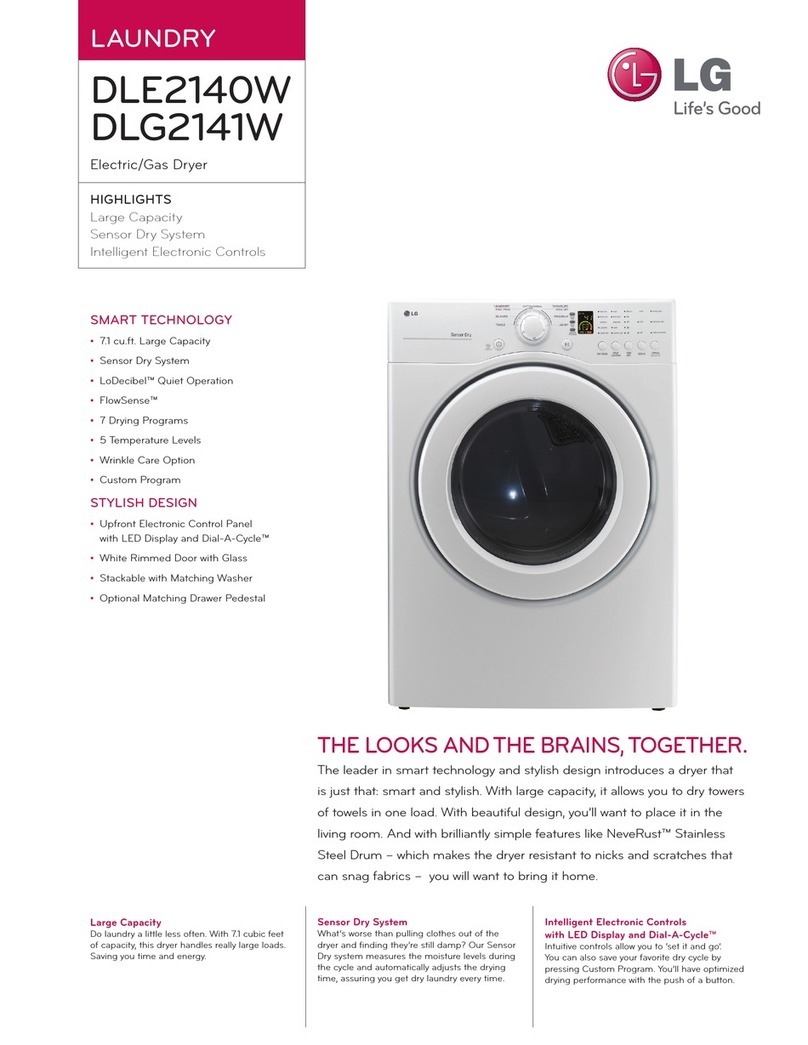
LG
LG DLE2140W specification

Kenmore
Kenmore Kenmore Gas Dryer 110.7506 Use & care guide
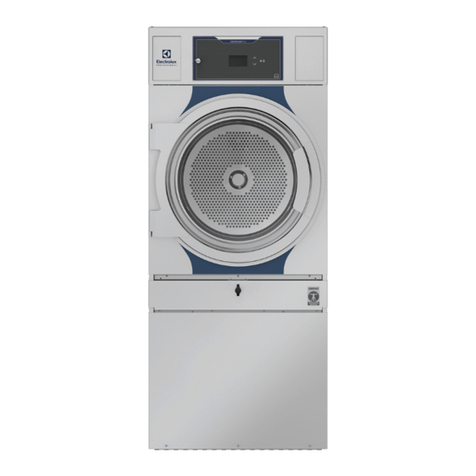
Electrolux Professional
Electrolux Professional Compass Pro TD6-16 installation manual

Frigidaire
Frigidaire GLER642CA Factory parts catalog
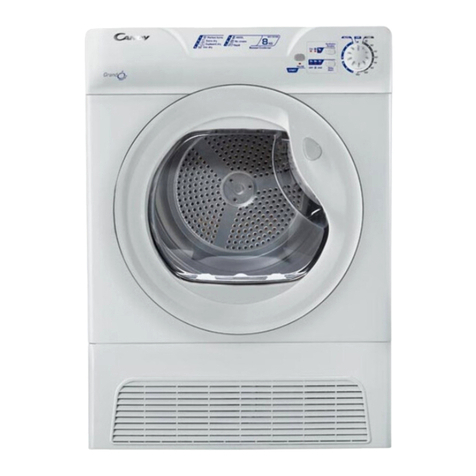
Candy
Candy GCC 581NB Instruction book
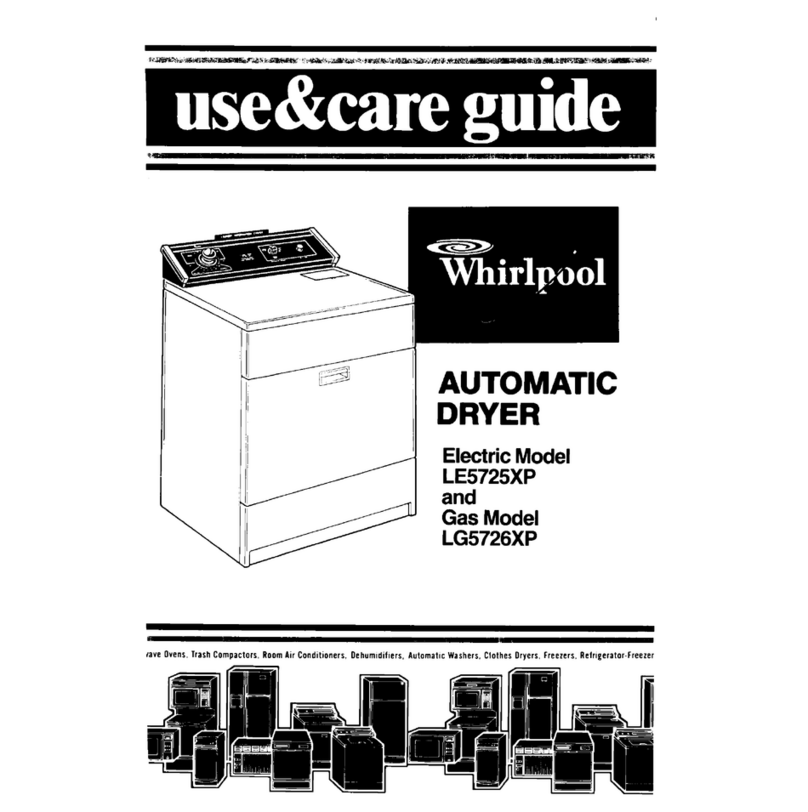
Whirlpool
Whirlpool LE5725XP Use & care guide
